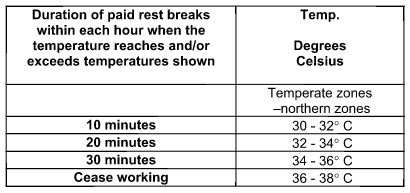
Working In Heat
Prepared by Peggy Trompf, Industrial Health Matters (in association with Workers Health Centre), Sydney.
While OHS Authorities have produced guidelines and information on working in hot conditions, there are no regulatory OHS standards for working in seasonal heat.
Workers need to have good information about the health risk of working on hot and humid conditions.
Employers must have comprehensive policies, training, and induction information inplace identifying all possible risks when working in hot environments.
The best control measures are to prevent the onset of heat stress.
What is heat stress?
A number of health effects - ranging from discomfort to serious illness.
Risk factors include air temperature, air movement and level of working activity; number of hours worked; clothing worn, particulary protective clothing; level of fluid loss and replacement; sources of heat in the workplace; acclimatisation: personal factors certain medications, pre - existng medical conditions, level of physical fitness and obesity.
Health and safety effects of heat stress
If the body is unable to use its natural cooling mechanism to stop a rise in body temperature, risk to health and safety will occur.
These may be skin rashes; dehydration; heat cramps; heat exhaustion, and heat stroke. It is important to know that there can be a rapid progression from heat exhaustion to heat stroke, and that the effects of severe heat stroke may be irreversible.
Employers must monitor employees for signs of heat illness, and act immediately.
Measuring temperature in the working environment
Monitor the temperature through-out the day, as close to the work site / work area as possible.
A normal, dry bulb, thermometer is recommended as the most convenient and satisfactory measure of seasonal temperature.
Use weather forecast to plan working arrangements when hot conditions are expected.
Amenities
The employer must provide access or allow access to an ongoing supply of good quality and accessible drinking water; air conditioned work areas, etc.
Rest breaks for working in heat
When work temperatures exceed 26°C, employers should take action to control the effects of heat stress. Rest breaks should be introduced and modified by negotiation to suit local conditions, and are important preventative measures.
Don’t wait till someone has heat stress illness.
This rest break table is a recommendation for negotiation, and variations might be needed for specific working conditions or circumstances.
The following table is a guideline which could be used in local discussions with management.
Outdoor work, where escape from the elements may be difficult or impossible, will require rest breaks and stop work to be initiated at lower temperatures. Contact the union for advice and assistance.
Reference: ACTU GUIDELINES FOR WORKING IN SEASONAL HEAT











